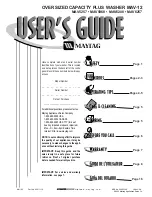
25
ENG
1°dH=1.25
°fH=0.178mmol/l
°Clarke=1.78
The factory setting: H3
Contact your local water board for information on the hardness of your water supply.
NOTE
Please check the sectiion 3 “Loadiing The Sallt iinto The Softener compartment” of PART I: Generic Version, If your
dishwasher lacks salt.
NOTE
If your model does not have any water softener compartment, you may skip this section.
Water Softener
The hardness of the water varies from place to place. If hard water is used in the dishwasher, deposits will form on
the dishes and utensils.
The appliance is equipped with a special softener that uses a salt container speciically designed to eliminate lime
and minerals from the water.
Preparing and Loading Dishes
• Consider buying utensils which are identiied as dishwasher-proof.
• For particular items, select a program with the lowest possible temperature.
• To prevent damage, do not take glass and cutlery out of the dishwasher immediately after the program has
ended.
For washing the following cutlery/dishes
Are not suitable
• Cutlery with wooden, horn china or mother-of-pearl handles
• Plastic items that are not heat resistant
• Older cutlery with glued parts that are not temperature resistant
• Bonded cutlery items or dishes
• Pewter or cooper items
• Crystal glass
• Steel items subject to rusting
• Wooden platters
• Items made from synthetic ibers
Are of limited suitability
• Some types of glasses can become dull after a large number of washes
• Silver and aluminum parts have a tendency to discolor during washing
• Glazed patterns may fade if machine washed frequently
Recommendations for loading the dishwasher
Scrape off any large amounts of leftover food. Soften remnants of burnt food in pans. It is not necessary to rinse the
dishes under running water.
For best performance of the dishwasher, follow these loading guidelines.
(Features and appearance of baskets
and cutlery baskets may vary from your model.)
Place objects in the dishwasher in following way:
• Items such as cups, glasses, pots/pans, etc. are faced downwards.
• Curved items, or ones with recesses, should be loaded aslant so that water can run off.
• All utensils should be stacked securely so to not tip over.
• All utensils are placed in the way that the spray arms can rotate freely during washing.
• Load hollow items such as cups, glasses, pans etc. With the opening facing downwards so that water cannot
collect in the container or a deep base.
• Dishes and items of cutlery must not lie inside one another, or cover each other. To avoid damage, glasses
should not touch one another.
• The upper basket is designed to hold more delicate and lighter dishware such as glasses, coffee and tea cups.
















































